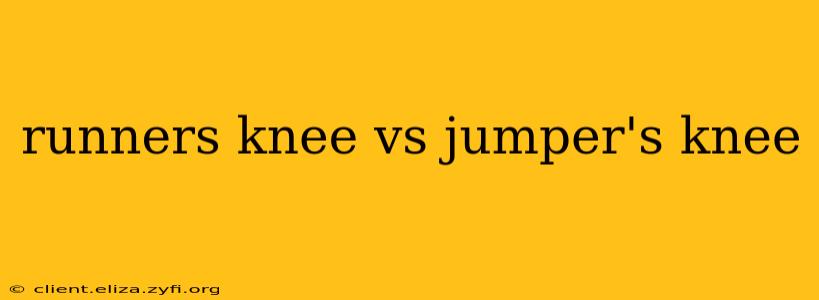Both runner's knee and jumper's knee are common knee pain conditions, often causing confusion due to their similar names. While both involve pain around the kneecap (patella), they stem from different overuse mechanisms and often affect different parts of the knee joint. Understanding the distinctions is crucial for proper diagnosis and treatment.
What is Runner's Knee (Patellofemoral Pain Syndrome)?
Runner's knee, also known as patellofemoral pain syndrome (PFPS), is a broad term encompassing pain around the kneecap. It's not a specific injury but rather a collection of symptoms resulting from overuse, muscle imbalances, and biomechanical issues. Runners frequently experience it, hence the name, but it can affect anyone engaging in activities that repeatedly stress the knee joint, including cyclists, hikers, and even individuals with sedentary lifestyles who suddenly increase their activity level.
The pain is usually felt around or behind the kneecap, often worsening with activities like running, climbing stairs, or prolonged sitting with bent knees. The pain might be dull, aching, or sharp, and can sometimes radiate down the leg.
What causes runner's knee?
Several factors contribute to runner's knee:
- Muscle imbalances: Weak or tight muscles surrounding the knee, particularly the quadriceps (thigh muscles) and hamstrings (back of the thigh), can lead to improper patellar tracking.
- Overuse: Repeated stress on the knee joint from running, jumping, or other activities can irritate the cartilage under the kneecap.
- Biomechanical issues: Problems with foot alignment, leg length discrepancies, or improper running form can increase stress on the knee.
- Sudden increase in activity: Jumping into intense workouts without proper conditioning can overload the knee joint.
What is Jumper's Knee (Patellar Tendinitis)?
Jumper's knee, or patellar tendinitis, is an inflammation of the patellar tendon, the tendon connecting the kneecap to the shinbone (tibia). It's a more specific injury than runner's knee, primarily affecting the tendon itself rather than the entire patellofemoral joint. While the name suggests it only affects jumpers, it can also occur in individuals involved in activities requiring repetitive jumping or forceful knee extensions, such as basketball, volleyball, and even weightlifting.
The pain is typically felt below the kneecap, at the point where the patellar tendon attaches to the tibia. The pain may be sharp, especially during jumping or landing, and often worsens after activity. There may also be tenderness to the touch in this area.
What causes jumper's knee?
Jumper's knee arises from repetitive stress and strain on the patellar tendon:
- Repetitive jumping: Activities involving repeated jumping place significant stress on the patellar tendon.
- Overuse: Overtraining or sudden increases in training intensity can overload the tendon.
- Poor landing technique: Improper landing mechanics can increase stress on the knee joint and patellar tendon.
- Weak quadriceps: Weak quadriceps muscles can increase the strain on the patellar tendon.
Runner's Knee vs. Jumper's Knee: Key Differences Summarized
| Feature | Runner's Knee (PFPS) | Jumper's Knee (Patellar Tendinitis) |
|---|---|---|
| Location of Pain | Around or behind the kneecap | Below the kneecap, at the patellar tendon |
| Underlying Cause | Overuse, muscle imbalances, biomechanics | Repetitive stress and strain on the tendon |
| Affected Tissue | Patellofemoral joint, cartilage | Patellar tendon |
| Common Activities | Running, cycling, hiking, stairs | Jumping, weightlifting, forceful knee extension |
How are Runner's Knee and Jumper's Knee Diagnosed?
Diagnosis typically involves a physical examination by a doctor or physical therapist. Imaging techniques like X-rays may be used to rule out other conditions, but are often not necessary for a diagnosis. A detailed history of symptoms and activities is essential.
Treatment for Runner's Knee and Jumper's Knee
Treatment for both conditions focuses on reducing pain and inflammation, improving muscle strength and flexibility, and correcting any biomechanical issues. This may involve:
- Rest and ice: Resting the affected knee and applying ice can help reduce pain and inflammation.
- Physical therapy: Strengthening exercises, stretching, and mobility exercises are crucial for improving muscle balance and patellar tracking.
- Medication: Over-the-counter pain relievers like ibuprofen or naproxen can help manage pain and inflammation. In some cases, a doctor might prescribe stronger pain relievers or anti-inflammatory medications.
- Bracing or taping: Knee braces or taping can help support the knee joint and improve patellar tracking.
- Injections: In severe cases, corticosteroid injections might be considered to reduce inflammation.
What are the long-term implications of untreated runner's knee and jumper's knee?
Untreated runner's knee and jumper's knee can lead to chronic pain, reduced mobility, and potentially more serious complications like cartilage damage or tendon rupture. Early diagnosis and intervention are crucial for preventing long-term problems.
This information is for general knowledge and does not constitute medical advice. Always consult with a healthcare professional for diagnosis and treatment of any knee pain.
